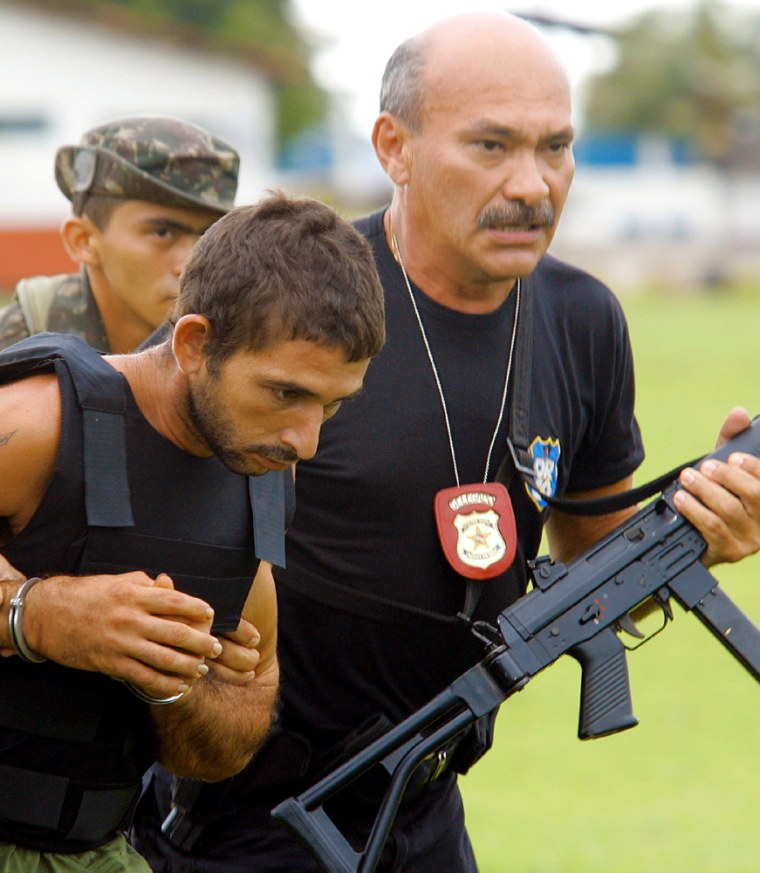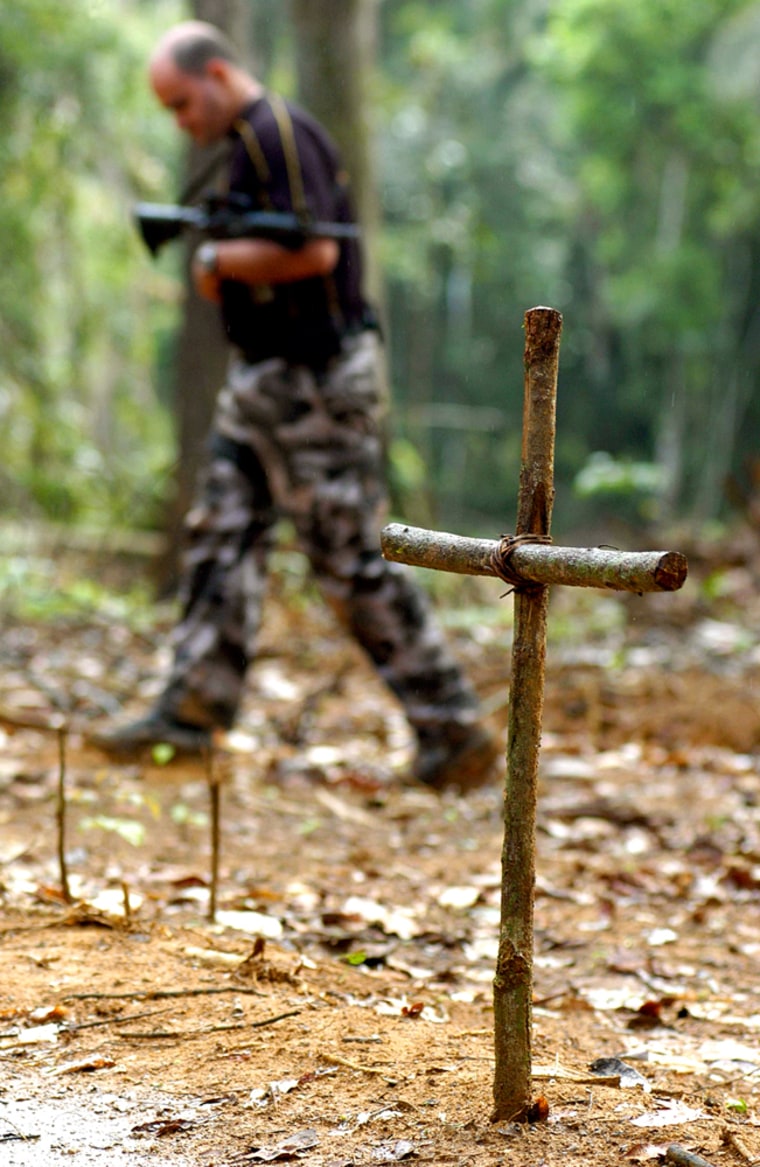A crude cross of tree branches marks the spot where American nun Dorothy Stang died on a red mud road cutting through dense green jungle. It also marks ground zero of a battle over how the Amazon, the world’s largest remaining tropical wilderness, will be developed — or destroyed.
Stang, 73, a spunky, softly spoken nun from Dayton, Ohio, was shot dead on Feb. 12 in a dispute with an influential rancher in the eastern Amazon state of Para, on the frontier of forest and development, where powerful interests collide with the Amazon’s poor.
“Before she came here, she was in southern Para, where loggers cut down everything, and she saw that model brought only disgrace for many and improvements for only a few,” said Felicio Pontes Jr., a federal prosecutor who often worked with Stang on land issues. “She vowed not to let that happen here.”
That vow cost Stang her life — and made her a symbol for rain forest defenders.
When Stang, a member of the Sisters of Notre Dame de Namur, was shot she became the most celebrated martyr to die defending the rain forest since Chico Mendes, the rubber tapper and guardian of the Amazon who was killed in 1988.
While Mendes’ death brought international attention, increased environmental awareness and government regulations, much has remained the same.
Stang tried to use laws
The Amazon is still a wild, mostly lawless region. Loggers, ranchers and developers are still cutting it down — about 20 percent of the 1.6 million square mile wilderness already has been destroyed.
An estimated 9,169 square miles of the Amazon rain forest was cut down in 2003, the last year for which government figures are available.
Like Mendes, Stang preached living in harmony with the forest rather than cutting it down for quick gain. But Stang, unlike Mendes, had a vast arsenal of environmental laws and land use regulations that strengthened her argument with ranchers.
Not that many listened.
“Dorothy would call up all the government agencies and demand this and that, and when they’d hang up on her she’d go to Belem (the state capital) or Brasilia and knock on their doors. She’d even open up their file cabinets,” remembers Claudia Marcia Cavalcante, 31, an agricultural technician with the farming cooperative formed by Stang.
Stang’s success earned her the hostility of local ranchers, who were used to grabbing whatever land they wanted, using forged deeds or no deeds at all.
“They throw up a fence and send ’pistoleiros’ to stay there and keep people out. If there are people there they burn down their huts and force them off at gun point,” explained Cavalcante.
Rancher apparently fled scene
According to witnesses, Stang was killed because she was trying to halt logging in an area of near-pristine jungle coveted by rancher Vitalmiro Goncalves Moura. Police are searching for Moura but think he fled the region after the killing.
Another suspect in her death, Amair Freijoli da Cunha, has surrendered to police in Altamira, a city about 80 miles from where Stang was killed, police said Saturday.
And on Sunday, police captured one of two suspected gunmen, identified as Rayfran das Neves Sales.

Cunha was accompanied by a lawyer and admitted knowing Moura but denied being involved in Stang’s killing, police said. Authorities say Cunha hired the two purported gunmen and served as the intermediary between the killers and Moura, whom police accuse of ordering the killing.
Stang claimed Moura had no right to the land where she wanted to create a Sustainable Development Project — where settlers are granted land if they agree to preserve the forest.
For weeks, men working for Moura knocked down and burned the settlers’ rickety thatched-roof huts in an attempt to expel them from the land.
“They kept burning down the huts and Dorothy kept having us put them back up. She ruined their plans, so they killed her,” said settler Raimundo Alfredo Campelo Maia, 39, who lives near the spot where Stang was killed.
Lifetime of helping others
Maia recalls taking long walks with Stang through the jungle to visit poor settlers, where she talked about her commitment to the poor and saving the environment.
“She always spent the night with the poorest people. She lived like they lived and ate what they ate,” said Maia.
She learned compassion early, growing up in a Catholic family during the post-Depression years with nine brothers and sisters.
The family wasted nothing, using tire treads to resole shoes and saving apple and potato peels for compost. Her younger sister Barbara recalled that the family welcomed the needy, taking in strangers for weeks until they found a job at a local factory.
Two of Stang’s brothers became priests. She went further, spending 23 years in this remote jungle region, quietly lobbying the government to improve education, the rutted dirt roads and health care.
She taught local residents to protect the environment and to form farming cooperatives to sell the fruits harvested from the forest.
In the past five years, Stang began to focus intently on environmental and land issues. The area was in transition, and government plans to pave the nearby Trans-Amazon highway and build a massive hydroelectric dam brought people flooding into the Anapu region.
Loggers also started moving in.
The dense jungle around the town was quickly cut down to make room for simple clapboard houses, and the jungle trails were widened to let logging trucks in.
Stang was a watchdog, alerting government agencies to environmental abuses and checking if loggers had legitimate land title. She received frequent death threats, and colleagues say she was part of a long list of union organizers and activists slated to die.
“She fought hard. Maybe with her blood she’ll accomplish in death what she couldn’t accomplish during her life,” said Rev. Lucas Rodriguez, a priest who work with Stang in the region for many years.
New protection, on paper at least
Amid an international outcry over Stang’s death, President Luiz Inacio Lula da Silva on Thursday put nearly 19,900 square miles of Amazon land under federal environmental protection and suspended logging in some hotly disputed areas.
But many worry that the protection will exist only on paper, and that illegal logging will continue. The Amazon is just too big to control, they say.
Jose Roberval de Souza, president of the local association of logging industries, called Stang a friend and said her death was tragic. But he blamed it on excessive regulations, saying they make legal logging difficult and encourage illegal activity and land grabbing.
“If you want us to stop logging, make a law and ban the practice altogether. We just want to know how we are supposed to work,” said Souza. “We are in favor of reserves but in a way that loggers can do their work.”
